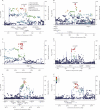Risk loci for chronic obstructive pulmonary disease: a genome-wide association study and meta-analysis
- PMID: 24621683
- PMCID: PMC4176924
- DOI: 10.1016/S2213-2600(14)70002-5
Risk loci for chronic obstructive pulmonary disease: a genome-wide association study and meta-analysis
Abstract
Background: The genetic risk factors for susceptibility to chronic obstructive pulmonary disease (COPD) are still largely unknown. Additional genetic variants are likely to be identified by genome-wide association studies in larger cohorts or specific subgroups. We sought to identify risk loci for moderate to severe and severe COPD with data from several cohort studies.
Methods: We combined genome-wide association analysis data from participants in the COPDGene study (non-Hispanic white and African-American ethnic origin) and the ECLIPSE, NETT/NAS, and Norway GenKOLS studies (self-described white ethnic origin). We did analyses comparing control individuals with individuals with moderate to severe COPD and with a subset of individuals with severe COPD. Single nucleotide polymorphisms yielding a p value of less than 5 × 10(-7) in the meta-analysis at loci not previously described were genotyped in individuals from the family-based ICGN study. We combined results in a joint meta-analysis (threshold for significance p<5 × 10(-8)).
Findings: Analysis of 6633 individuals with moderate to severe COPD and 5704 control individuals confirmed association at three known loci: CHRNA3 (p=6·38 × 10(-14)), FAM13A (p=1·12 × 10(-14)), and HHIP (p=1·57 × 10(-12)). We also showed significant evidence of association at a novel locus near RIN3 (p=5·25 × 10(-9)). In the overall meta-analysis (ie, including data from 2859 ICGN participants), the association with RIN3 remained significant (p=5·4 × 10(-9)). 3497 individuals were included in our analysis of severe COPD. The effect estimates for the loci near HHIP and CHRNA3 were significantly stronger in severe disease than in moderate to severe disease (p<0·01). We also identified associations at two additional loci: MMP12 (overall joint meta-analysis p=2·6 × 10(-9)) and TGFB2 (overall joint meta-analysis p=8·3 × 10(-9)).
Interpretation: We have confirmed associations with COPD at three known loci and identified three new genome-wide significant associations. Genetic variants other than in α-1 antitrypsin increase the risk of COPD.
Funding: US National Heart, Lung, and Blood Institute; the Alpha-1 Foundation; the COPD Foundation through contributions from AstraZeneca, Boehringer Ingelheim, Novartis, and Sepracor; GlaxoSmithKline; Centers for Medicare and Medicaid Services; Agency for Healthcare Research and Quality; and US Department of Veterans Affairs.
Copyright © 2014 Elsevier Ltd. All rights reserved.
Figures


Comment in
-
COPD: no gene left unturned.Lancet Respir Med. 2014 Mar;2(3):171-2. doi: 10.1016/S2213-2600(14)70026-8. Epub 2014 Feb 7. Lancet Respir Med. 2014. PMID: 24621676 No abstract available.
References
-
- Minino M, Xu J, Kochanek J. Deaths: Preliminary Data for 2008. National Vital Statistics Reports. Hyattsville, MD: National Center for Vital Statistics. Natl Cent Vital Stat. 2010;59 - PubMed
-
- Vestbo J, Hurd SS, Agustí AG, et al. Global Strategy for the Diagnosis, Management, and Prevention of Chronic Obstructive Pulmonary Disease: GOLD Executive Summary. Am J Respir Crit Care Med. 2013;187:347–65. - PubMed
-
- Burrows B, Knudson RJ, Cline MG, Lebowitz MD. Quantitative relationships between cigarette smoking and ventilatory function. 1977;115:195–205. - PubMed
-
- Ingebrigtsen T, Thomsen SF, Vestbo J, et al. Genetic influences on Chronic Obstructive Pulmonary Disease - a twin study. Respir Med. 2010;104:1890–5. - PubMed
-
- McCloskey SC, Patel BD, Hinchliffe SJ, Reid ED, Wareham NJ, Lomas DA. Siblings of patients with severe chronic obstructive pulmonary disease have a significant risk of airflow obstruction. Am J Respir Crit Care Med. 2001;164:1419–24. - PubMed
Publication types
MeSH terms
Grants and funding
- R01 HL113264/HL/NHLBI NIH HHS/United States
- N01 HR076102/HL/NHLBI NIH HHS/United States
- R25 ES011080/ES/NIEHS NIH HHS/United States
- N01 HR076105/HL/NHLBI NIH HHS/United States
- N01 HR076118/HL/NHLBI NIH HHS/United States
- N01 HR076115/HR/NHLBI NIH HHS/United States
- N01 HR076107/HL/NHLBI NIH HHS/United States
- G0901786/MRC_/Medical Research Council/United Kingdom
- R01 HL089897/HL/NHLBI NIH HHS/United States
- N01 HR076103/HL/NHLBI NIH HHS/United States
- UL1 TR000005/TR/NCATS NIH HHS/United States
- P01 HL083069/HL/NHLBI NIH HHS/United States
- UL1 TR001079/TR/NCATS NIH HHS/United States
- N01 HR076114/HL/NHLBI NIH HHS/United States
- T32 ES007142/ES/NIEHS NIH HHS/United States
- K08 HL097029/HL/NHLBI NIH HHS/United States
- N01 HR076113/HL/NHLBI NIH HHS/United States
- U01 HL089897/HL/NHLBI NIH HHS/United States
- N01 HR076104/HL/NHLBI NIH HHS/United States
- R01 HL089856/HL/NHLBI NIH HHS/United States
- N01 HR076101/HL/NHLBI NIH HHS/United States
- N01 HR076110/HL/NHLBI NIH HHS/United States
- U01 HL089856/HL/NHLBI NIH HHS/United States
- N01 HR076112/HL/NHLBI NIH HHS/United States
- P01 HL105339/HL/NHLBI NIH HHS/United States
- N01HR76117/HR/NHLBI NIH HHS/United States
- N01 HR076109/HL/NHLBI NIH HHS/United States
- N01 HR076119/HL/NHLBI NIH HHS/United States
- N01 HR076108/HL/NHLBI NIH HHS/United States
- N01 HR076116/HL/NHLBI NIH HHS/United States
- N01 HR076111/HL/NHLBI NIH HHS/United States
- R01 HL084323/HL/NHLBI NIH HHS/United States
- N01 HR076106/HL/NHLBI NIH HHS/United States
LinkOut - more resources
Full Text Sources
Other Literature Sources
Medical
Miscellaneous

